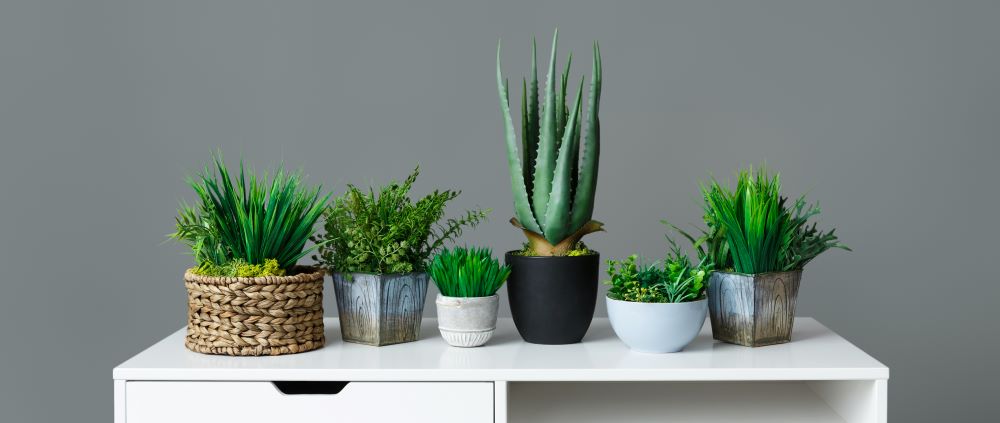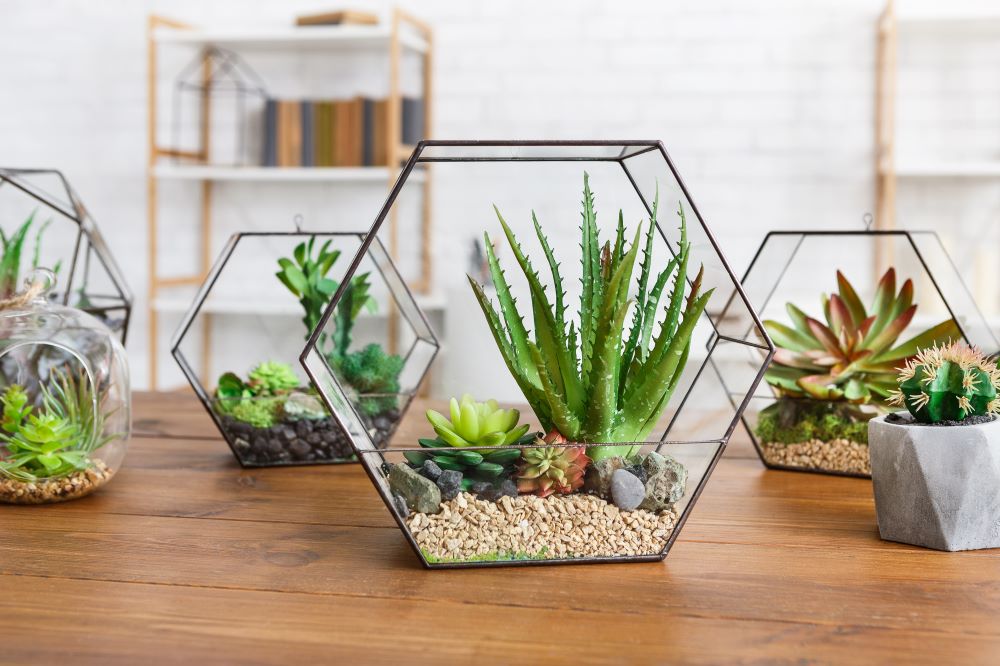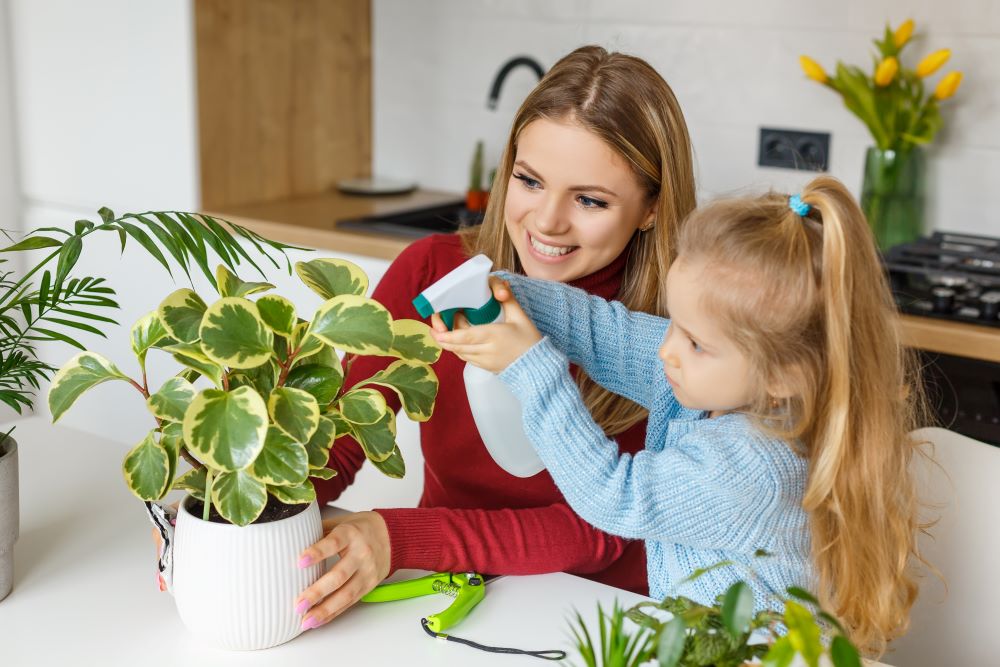Bringing the beauty of the outdoors inside is a timeless trend in home decor. Indoor green plants enhance the aesthetics of your living spaces and offer numerous health benefits.
From purifying the air to reducing stress, these botanical wonders are versatile additions to any home. In this article, we’ll explore the health benefits of indoor plants, ways to decorate your home with indoor green plants, and share tips on creating and maintaining a harmonious green oasis.
Indoor plants do much more than just enhance the visual appeal of your home; they offer a range of health benefits that can positively impact your well-being.
Health Benefits of Indoor Plants
Improved Air Quality:
Indoor plants act as natural air purifiers, removing toxins and chemicals from the air. They absorb carbon dioxide and release oxygen during photosynthesis, thereby increasing oxygen levels and improving air quality.
Reduced Stress and Anxiety:
Indoor plants have been linked to reduced stress and anxiety levels. The act of caring for plants and being surrounded by greenery can promote relaxation and a sense of well-being.
Enhanced Mood:
Indoor plants can boost your mood and help reduce feelings of depression and loneliness. Their vibrant colours and soothing green tones create a more pleasant and calming environment.
Better Focus and Productivity:
Studies have shown that indoor plants in workspaces can increase productivity and concentration. They help reduce mental fatigue and improve cognitive function.
Humidity Regulation:
Many indoor plants release moisture through a process called transpiration, which can help maintain optimal indoor humidity levels.
Improved Sleep:
Some indoor plants, like lavender and jasmine, release calming scents that can improve sleep quality. Additionally, the oxygen released by plants can promote better breathing and deeper sleep.
Allergy Relief:
Certain indoor plants, such as snake plants and peace lilies, can help remove allergens like dust and mould spores from the air, providing relief to individuals with allergies.
Faster Healing:
Research suggests that the presence of indoor plants in hospital rooms can speed up the recovery process for patients. They create a more positive and healing environment.
Noise Reduction:
Large, leafy indoor plants can absorb and muffle sound, reducing background noise levels and creating a quieter living or working space.
Increased Creativity:
Some studies have indicated that indoor plants can stimulate creativity and problem-solving abilities. Their presence can inspire fresh ideas and innovative thinking.
Connection with Nature:
For those living in urban environments or without access to outdoor green spaces, indoor plants provide a connection to nature. They remind us of the beauty and tranquillity of the natural world.
Boosted Immune System:
Exposure to beneficial microorganisms found in potting soil can help strengthen the immune system and reduce the risk of illness.

Ways to Decorate with Indoor Plants
1. Choose the Right Plants
The first step in creating a lush indoor garden is selecting the right indoor plants. Consider the following factors:
- Light Conditions: Different plants have different light requirements. Assess the natural light available in your home and choose plants that thrive in low, medium, or bright light environments.
- Maintenance Level: Some plants require more care and attention than others. If you’re a novice plant owner, start with low-maintenance varieties like snake plants, pothos, or succulents.
- Space: Determine the available space in your home. While some plants are compact, others can grow quite large. Make sure you have enough room for your chosen plants to flourish.
- Personal Preferences: Select plants that resonate with your personal style and taste. Whether you prefer lush foliage or unique shapes, there’s a plant to suit every aesthetic.
2. Consider Planters and Pots
The choice of planters and pots can significantly impact your home’s decor. Here are some ideas:
- Terracotta Pots: These classic clay pots provide excellent drainage and a rustic, earthy look.
- Modern Planters: Sleek, minimalist planters in materials like ceramic or metal can add a contemporary touch to your decor.
- Hanging Planters: Maximise vertical space by suspending plants in stylish hanging planters. They’re perfect for trailing plants like ivy or ferns.
- Decorative Plant Stands: Elevate your plants, literally, with decorative plant stands. These come in various styles and heights, adding visual interest to your space.
- Repurposed Containers: Get creative by using vintage teacups, mason jars, or old wooden crates as unique plant containers.
3. Grouping and Placement
Arranging your indoor plants strategically can transform your space. Consider the following placement ideas:
- Focal Point: Create a stunning centrepiece by placing a large, eye-catching plant in the centre of a room or on a prominent shelf.
- Clustered Groupings: Group smaller plants together on a table or windowsill for a vibrant display.
- Vertical Gardens: Install wall-mounted planters or shelves to make the most of vertical space. This is especially useful in smaller homes.
- Corner Plants: Soften the corners of rooms with tall, elegant plants like fiddle leaf figs or palms.
- Kitchen Greens: The kitchen is a perfect place to have potted basil and parsley to elevate your cooking and give aesthetic vibes.
In New Zealand, where climate conditions can vary from region to region, there’s a wide array of indoor plants that can thrive in Kiwi homes.
Popular Indoor Plants
- Fiddle Leaf Fig (Ficus lyrata): Known for its large, glossy leaves, the fiddle leaf fig is a favourite among plant enthusiasts in New Zealand. It adds a touch of elegance and tropical charm to any room.
- Monstera Deliciosa: This trendy plant with its distinctive Swiss cheese-like leaves is stylish and easy to care for. It adapts well to New Zealand’s indoor climate.
- Peace Lily (Spathiphyllum): The Peace Lily is a fantastic air purifier and is well-suited for New Zealand homes. Its graceful white blooms and dark green foliage make it a popular choice for both beginners and experienced plant lovers.
- Pothos (Epipremnum aureum): Pothos is a versatile trailing plant that can thrive in various light conditions. Its heart-shaped leaves add a touch of greenery and charm to any space.
- Spider Plant (Chlorophytum comosum): Spider plants are hardy and adapt well to New Zealand’s indoor environments. Their arching green and white striped leaves are a classic choice for homes.
- Succulents: New Zealand’s climate is suitable for growing a variety of succulents, from the classic Echeveria to the more unique Haworthia and Crassula varieties. These low-maintenance plants are perfect for Kiwi homes.
- Snake Plant (Sansevieria): Also known as the mother-in-law’s tongue, snake plants thrive in low light conditions, making them ideal for areas with limited sunlight.

Top Tips to Maintain Your Indoor Plants
Light is Important
- Understand your plant’s light requirements (low, medium, or bright).
- Place plants near suitable windows or use grow lights for adequate light exposure.
Plants Need Water
- Water your plants according to their specific needs; overwatering is a common issue.
- Use a well-draining potting mix and allow excess water to escape through drainage holes.
- Water thoroughly, but ensure the pot doesn’t sit in standing water.
Humidity Matters:
- Maintain proper humidity levels, especially for tropical plants, using a humidity tray, room humidifier, or misting.
Watch The Temperature:
- Keep indoor plants within their preferred temperature range; avoid extreme temperature fluctuations.
Pruning and Trimming:
- Regularly trim dead or yellowing leaves and spent flowers to encourage new growth.
- Prune to maintain the desired shape and size of your plant.
Fertilising:
- Follow a regular fertilisation schedule with a balanced liquid or granular fertiliser designed for indoor plants.
- Reduce fertilisation during the plant’s dormant period (usually in winter).
Pests and Disease:
- Inspect plants regularly for signs of pests (e.g., aphids, mealybugs) and treat them promptly if detected.
- Isolate new plants for a few weeks to prevent introducing pests to your collection.
Repotting Your Plants:
- Repot plants when they outgrow their containers, typically every 1-2 years.
- Choose a slightly larger pot with good drainage and fresh potting soil.
Support and Staking:
- Provide support for tall or leggy plants with stakes or trellises.
- Use soft ties or string to secure the plant gently without damaging the stems.
Rotation For Even Growth:
- Rotate your plants periodically to ensure even growth and prevent them from leaning towards the light source.
Cleaning Helps Too:
- Wipe down leaves with a damp cloth to remove dust and allow the plant to breathe better.
Observation:
- Pay attention to your plant’s behaviour and adapt care routines as needed.
- Learn about the specific needs of each plant type in your collection.
Conclusion
When choosing indoor green plants for your New Zealand home, it’s essential to consider your specific location and the amount of light your space receives. Remember that while these plants are generally well-suited to New Zealand’s climate, individual care requirements may vary, so always research and cater to the specific needs of your chosen plants to help them thrive. Happy decorating!
Are you keen on yoga? Take a look at our beginners guide to yoga poses.
